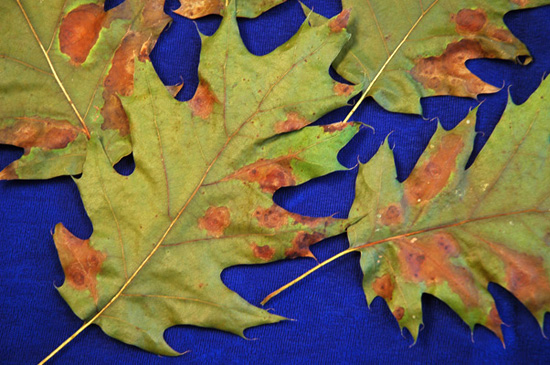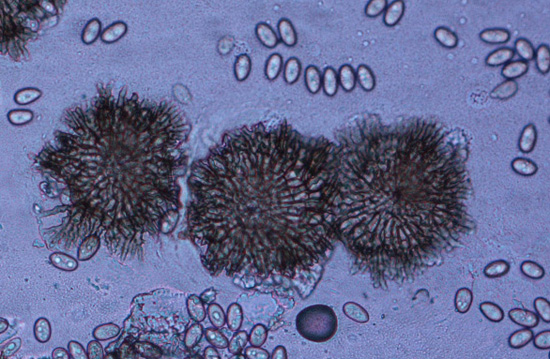Issue 18, October 16, 2009
Oak Leaf Spot
Tubakia leaf spot infects oak and sounds relatively harmless. After all, it is only a leaf spot disease and usually on large oak trees. This year, however, we saw more of this disease than any of the Plant Clinic staff can ever remember seeing in the past. One of us has been here for nearly 30 years.
The fungal pathogen of this leaf spot disease is Tubakia dryina. According to scientific literature, hosts might include oaks, maple, hickory, chestnut, redbud, ash, tupelo, sourwood, rose, sassafras, and elm. Still, the only host we have confirmed at the Plant Clinic is oak. This year we found it on 26 oak samples, and I found it easily on oaks throughout Champaign/Urbana. Stressed trees are more likely to be infected. Pin oaks with iron chlorosis are commonly infected with Tubakia leaf spot as well.
Symptoms appear as large leaf spots, appearing in midsummer. On oak leaves, a small spot is surrounded by a much larger brown area of necrosis, as seen in the image. The fungus secretes plant toxins which are thought to be responsible for the large lesions. They are easy to identify. If we look closer in the lab we can find the very distinct fruiting bodies of the fungus. They are called pycnothyrium and they look like large discs composed of mycelia and spores. The image shows these fruiting bodies, along with the oval spores of the fungus, as viewed with one of the Plant Clinic microscopes.


So why did we see so much of this disease in 2009? The disease cycle has not been described in detail. We know that the fungus overwinters on fallen leaves. Moist and moderate temperatures are thought to allow the spread of this fungus. Often, we only see infection in the early part of the season, but this year, infection intensified as the season progressed. It is likely that repeated rain events this summer allowed repeated infections and spread of the disease. We also saw early leaf drop in heavily infected trees.
Treatment with fungicides is not usually recommended. In order for fungicides to be effective, sprays would be required at bud break to prevent early infection and then repeated as long as rain events occurred. It would be very costly to make even one application on a large oak tree. Additionally, in most years we do not see enough of this disease to cause a problem. After a heavy disease year like 2009, rake and remove leaves. Stressed trees should be examined to find the source of stress and that source alleviated.--Nancy Pataky
Author:
Nancy Pataky